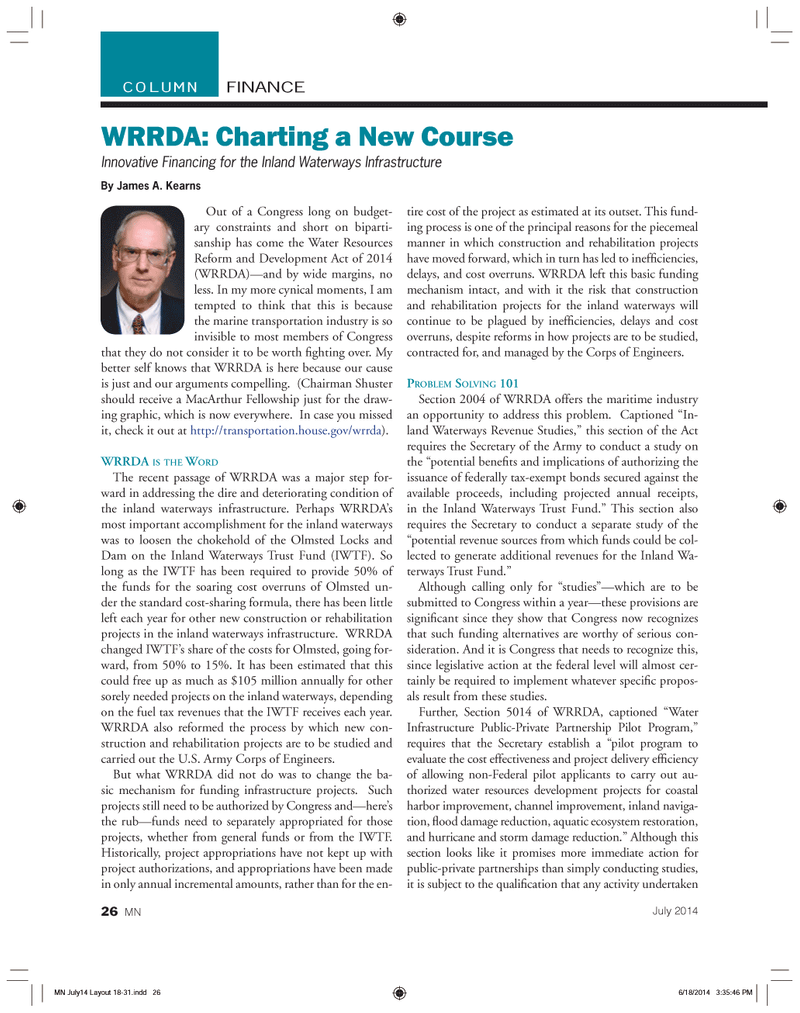
Page 26: of Marine News Magazine (July 2014)
ATB Technical Trends
Read this page in Pdf, Flash or Html5 edition of July 2014 Marine News Magazine
Out of a Congress long on budget- ary constraints and short on biparti- sanship has come the Water Resources Reform and Development Act of 2014 (WRRDA)?and by wide margins, no less. In my more cynical moments, I am tempted to think that this is because the marine transportation industry is so invisible to most members of Congress that they do not consider it to be worth ghting over. My better self knows that WRRDA is here because our cause is just and our arguments compelling. (Chairman Shuster should receive a MacArthur Fellowship just for the draw- ing graphic, which is now everywhere. In case you missed it, check it out at http://transportation.house.gov/wrrda ).WRRDA IS THE WORDThe recent passage of WRRDA was a major step for- ward in addressing the dire and deteriorating condition of the inland waterways infrastructure. Perhaps WRRDA?s most important accomplishment for the inland waterways was to loosen the chokehold of the Olmsted Locks and Dam on the Inland Waterways Trust Fund (IWTF). So long as the IWTF has been required to provide 50% of the funds for the soaring cost overruns of Olmsted un- der the standard cost-sharing formula, there has been little left each year for other new construction or rehabilitation projects in the inland waterways infrastructure. WRRDA changed IWTF?s share of the costs for Olmsted, going for- ward, from 50% to 15%. It has been estimated that this could free up as much as $105 million annually for other sorely needed projects on the inland waterways, depending on the fuel tax revenues that the IWTF receives each year. WRRDA also reformed the process by which new con- struction and rehabilitation projects are to be studied and carried out the U.S. Army Corps of Engineers. But what WRRDA did not do was to change the ba- sic mechanism for funding infrastructure projects. Such projects still need to be authorized by Congress and?here?s the rub?funds need to separately appropriated for those projects, whether from general funds or from the IWTF. Historically, project appropriations have not kept up with project authorizations, and appropriations have been made in only annual incremental amounts, rather than for the en- tire cost of the project as estimated at its outset. This fund- ing process is one of the principal reasons for the piecemeal manner in which construction and rehabilitation projects have moved forward, which in turn has led to inef ciencies, delays, and cost overruns. WRRDA left this basic funding mechanism intact, and with it the risk that construction and rehabilitation projects for the inland waterways will continue to be plagued by inef ciencies, delays and cost overruns, despite reforms in how projects are to be studied, contracted for, and managed by the Corps of Engineers. PROBLEM SOLVING 101Section 2004 of WRRDA offers the maritime industry an opportunity to address this problem. Captioned ?In- land Waterways Revenue Studies,? this section of the Act requires the Secretary of the Army to conduct a study on the ?potential bene ts and implications of authorizing the issuance of federally tax-exempt bonds secured against the available proceeds, including projected annual receipts, in the Inland Waterways Trust Fund.? This section also requires the Secretary to conduct a separate study of the ?potential revenue sources from which funds could be col- lected to generate additional revenues for the Inland Wa- terways Trust Fund.? Although calling only for ?studies??which are to be submitted to Congress within a year?these provisions are signi cant since they show that Congress now recognizes that such funding alternatives are worthy of serious con- sideration. And it is Congress that needs to recognize this, since legislative action at the federal level will almost cer- tainly be required to implement whatever speci c propos- als result from these studies. Further, Section 5014 of WRRDA, captioned ?Water Infrastructure Public-Private Partnership Pilot Program,? requires that the Secretary establish a ?pilot program to evaluate the cost effectiveness and project delivery ef ciency of allowing non-Federal pilot applicants to carry out au- thorized water resources development projects for coastal harbor improvement, channel improvement, inland naviga- tion, ood damage reduction, aquatic ecosystem restoration, and hurricane and storm damage reduction.? Although this section looks like it promises more immediate action for public-private partnerships than simply conducting studies, it is subject to the quali cation that any activity undertaken FINANCECOLUMNWRRDA: Charting a New Course Innovative Financing for the Inland Waterways Infrastructure By James A. KearnsJuly 201426 MNMN July14 Layout 18-31.indd 26MN July14 Layout 18-31.indd 266/18/2014 3:35:46 PM6/18/2014 3:35:46 PM

 25
25

 27
27
